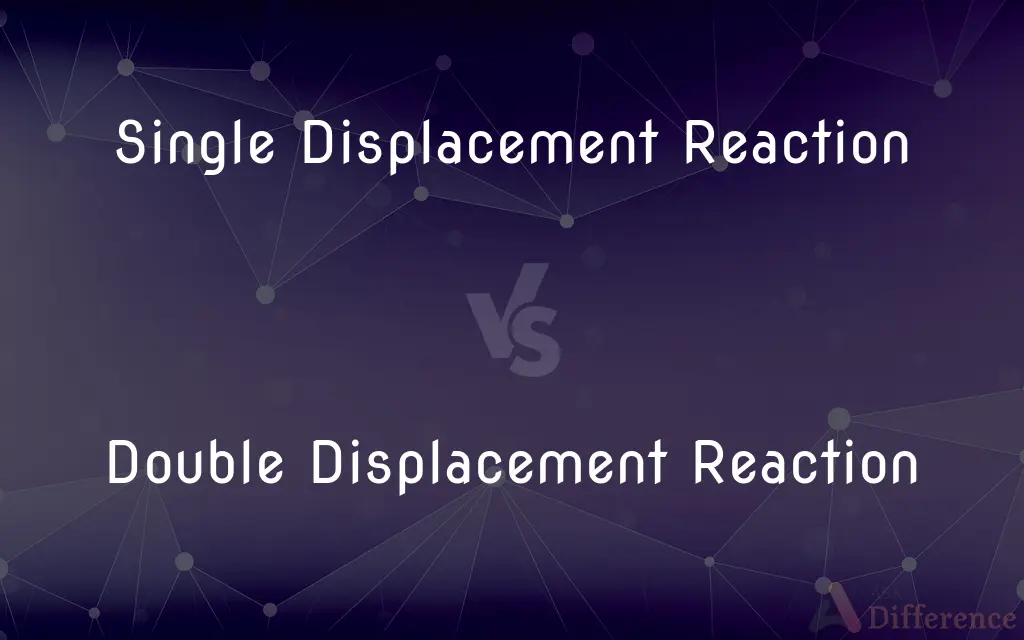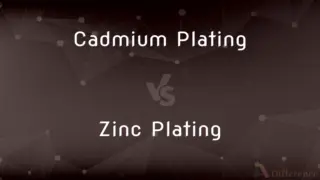Single Displacement Reaction vs. Double Displacement Reaction — What's the Difference?
By Tayyaba Rehman — Published on January 6, 2024
In a single displacement reaction, one element replaces another in a compound; in a double displacement reaction, two elements swap places between compounds.

Difference Between Single Displacement Reaction and Double Displacement Reaction
Table of Contents
ADVERTISEMENT
Key Differences
A single displacement reaction involves one element being replaced by another element in a compound. For example, in the reaction
A
+
BC
→
ADVERTISEMENT
AC
B
A+BC→AC+B, element A replaces B in the compound BC to form a new compound AC, and B is displaced.
In contrast, a double displacement reaction involves two compounds where parts of the original compounds exchange places, forming two new compounds. It follows the general form
AB
CD
AD
CB
AB+CD→AD+CB, where A and C switch places, resulting in AD and CB.
Single displacement reactions can be further classified into cationic and anionic types, depending on whether an anion or a cation is displaced. These reactions often occur in ionic compounds and can be seen in redox reactions where oxidation and reduction occur.
Double displacement reactions typically occur between two ionic compounds and often result in the formation of a precipitate, a gas, or a weak electrolyte. These reactions are also known as metathesis reactions.
In single displacement reactions, there is a movement of one ion or atom whereas, in double displacement reactions, there is a mutual exchange of ions or bonds between the reacting species.
Comparison Chart
Number of Elements/Compounds Involved
One element and one compound interact
Two compounds interact
Type of Exchange
One element replaces another in a compound
Ions or atoms from two compounds exchange
Reaction Outcome
Forms one new compound and one element
Forms two new compounds
Occurrence
Often in redox reactions
Often results in precipitation or gas formation
Compare with Definitions
Single Displacement Reaction
Characterized by the release of one element from a compound.
Potassium reacts with water, displacing hydrogen and forming potassium hydroxide.
Double Displacement Reaction
Also known as metathesis.
Lead
Single Displacement Reaction
Can result in oxidation or reduction.
A strip of magnesium metal will react with hydrochloric acid, displacing hydrogen gas.
Double Displacement Reaction
Two compounds exchange ions or elements.
Sodium carbonate reacts with calcium chloride to form calcium carbonate and sodium chloride.
Single Displacement Reaction
II sulfate, forming iron
II sulfate and copper.
Double Displacement Reaction
II nitrate reacts with potassium iodide, resulting in the formation of lead
II iodide and potassium nitrate.
Single Displacement Reaction
An element replaces another in a compound.
Zinc displaces copper in CuSO4 to form ZnSO 4.
Double Displacement Reaction
Involves two ionic compounds.
Ammonium sulfate and barium nitrate react to form barium sulfate and ammonium nitrate.
Single Displacement Reaction
Occurs in aqueous solutions with metals and salts.
Silver nitrate reacts with sodium chloride, causing silver to displace sodium.
Double Displacement Reaction
A reaction producing a precipitate, gas, or water.
When barium chloride reacts with sulfuric acid, a precipitate of barium sulfate forms.
Single Displacement Reaction
A reaction involving an exchange between an element and a compound.
Iron reacts with copper
Double Displacement Reaction
Often observable as an immediate cloudiness.
Mixing aqueous solutions of silver nitrate and sodium chloride forms a white precipitate of silver chloride.
Common Curiosities
What defines a single displacement reaction?
It's when one element displaces another in a compound.
Can a single displacement reaction involve nonmetals?
Yes, nonmetals can displace other nonmetals.
Can all metals undergo single displacement reactions?
Only metals that are more reactive than the metal in the compound.
What is required for a double displacement reaction to occur?
Both reactants must be soluble in the solvent used.
How do you balance a single displacement reaction equation?
By ensuring the number of atoms for each element is equal on both sides.
What type of compounds usually participate in double displacement reactions?
Ionic compounds are typical participants.
Do single displacement reactions always involve ions?
Not always, but often they involve the exchange of ionic species.
What is a characteristic product of a double displacement reaction?
Precipitate, gas, or a weak electrolyte.
How can you predict the products of a double displacement reaction?
By using the solubility rules and knowing the reactivity of ions.
Why don't all double displacement reactions result in a visible change?
Sometimes the products are soluble and remain in solution.
What's a key sign a single displacement reaction has occurred?
The appearance of a new element and a new compound.
Is it possible to have a single displacement reaction without a metal?
Yes, halogens can also participate in single displacement reactions.
Can a single displacement reaction be a redox reaction?
Yes, many single displacement reactions involve redox processes.
Are double displacement reactions reversible?
Some can be, depending on the reaction conditions.
What factors affect the rate of double displacement reactions?
Temperature, concentration, and the nature of the reactants.
Share Your Discovery

Previous Comparison
AC Motor vs. DC Motor
Next Comparison
Cadmium Plating vs. Zinc PlatingAuthor Spotlight
Written by
Tayyaba RehmanTayyaba Rehman is a distinguished writer, currently serving as a primary contributor to askdifference.com. As a researcher in semantics and etymology, Tayyaba's passion for the complexity of languages and their distinctions has found a perfect home on the platform. Tayyaba delves into the intricacies of language, distinguishing between commonly confused words and phrases, thereby providing clarity for readers worldwide.












































